Unfortunately, the Veterinary Medicines Directorate contacted me to tell me it was against the law to advertise this wormer since it was classed as ‘Prescription Only Medicine – Veterinarian, Pharmacist, Suitably Qualified Person (POM-VPS)’. and that ‘Products classed as POM-VPS can only be advertise in publications aimed at professional bodies and not to the general public’.
I was surprised they considered this page as advertising so I spoke to them and they advised me that I should not use the product’s brand name but could say ‘A product containing Flubendazole‘. As a result, I have removed the product name.
Before using medication to worm your chickens, it is best to check they need worming first by using a Worm Count Kit like this one. This is a simple test where a sample is sent off by post and the results are returned to you (usually by email) and will advise you whether or not you should worm your chickens.
In the United Kingdom, a product containing the anthelmintic (wormer) Flubendazole is currently the only licensed in feed product available for chickens. It is very effective at killing worms and their eggs. Worms can cause a huge amount of damage to chickens and cause many health problems. As a rule of thumb, if I have a sick bird, the first thing I consider is whether or not she was wormed recently before exploring other avenues because so many signs of illness can be as a result of worms.
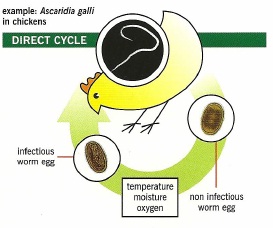
The Direct Life Cycle
Worms lay thousands of eggs in a day that are not always visible in droppings. Eggs then either get picked up by birds scratching around the floor, eating from the ground or in their litter when housed (i.e. picked up directly) or are eaten by earthworms or other ‘hosts’ and passed on to our birds when they themselves get eaten (i.e. indirectly picked up).
These two routes of infection are called the ‘Direct Life-cycle’ and the ‘Indirect Life-cycle’ and can be understood better from the diagrams show that are kindly supplied by Elanco (formerly Janssen Animal Health) where two examples of direct infection and one indirect are shown.
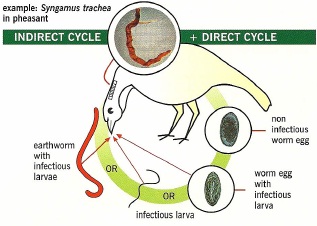
The Indirect Cycle
Worm eggs are destroyed by heat, drought, a hard frost and UV from direct sunlight. For this last reason, I keep grass short in runs over the hotter summer months where my hens graze so that worm eggs can be destroyed. Over the colder winter months or below 10 degrees Centigrade. Worm eggs cannot mature and therefore cannot become infectious so I test my hens with a worm count kit and worm if necessary in the Autumn as the temperature starts to drop and in the Spring when worms become active again.
This product containing Flubendazole that I’m not allowed to name is very effective and after the recommended 7 day treatment, chickens are free of worms and eggs. One thing to remember is that the thousands of eggs deposited via droppings (or coughed up in the case of Gape Worm) are still present in the environment so if the worm infestation is bad, you will need to repeat treatment after 3 weeks to break the cycle before the newly acquired worms (picked up from the eggs) have a chance to mature and lay eggs themselves.
The withdrawal period stated on the tub is nil for eggs from laying hens. This means that you can continue to eat eggs whilst your chickens are being wormed. I’m sure you won’t be eating your hens but they must not be slaughtered for human consumption during treatment. Treated birds may be slaughtered only after 7 days from the last treatment.
Where to buy
If you have a small flock, there is a 60g pack sufficient to treat around 20 large chickens. This comes with a handy little measuring scoop so that you can get the quantity right. One 6 g scoop treats 2 kg of food for chickens. This is the simplest way to worm and if you mix it as I suggest above with a little oil, you can be sure your chooks are getting the required amount. There is also a 240g tub or gamekeeper pack which is more suited to 50 birds or more and lasts longer.
Because of the tight regulations and a license that sellers need to hold (costing over £600 I was told by one company), both of these products are becoming harder and harder to buy. I bought a 60g tub in 1998 and paid £12.50. A year ago I bought another one and it was £70! Serious money.
The product containing Flubendazole can also be purchased pre-mixed in layers pellets on websites such as Amazon in 5 or 20Kg bags which is handy if you don’t want to mix it yourself.
I haven’t seen many places selling this product containing Flubendazole online and vets don’t usually stock it unless they specialise in poultry. The ‘regulations’ are pushing people to go to their vets or other suitably qualified people yet in fact if you chat to chicken keepers, they are being offered offer other large animal wormers containing Ivermectin instead that are often bought in large packs for use on farm animals. These haven’t been tested on chickens so you end up with vets advising anything from a 7 to 30 day withdrawal periods for eggs (depending on the view of the vet of what will be ‘safe’) and although this is perfectly legal, my personal opinion is that this is wrong when there is a tested product available.
How I mix this product containing Flubendazole
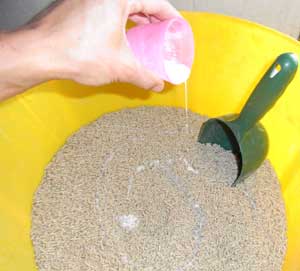
Adding the ‘paste’ to the layers pellets before mixing well
If you but the pack or tub then it will come as a powder that must be mixed with your chickens feed. In order to get this to stick to my layers pellets, I mix it in a small tub with a little Olive or Cod Liver Oil. The ‘paste’ that this makes can then be poured over the right amount of (weighed) pellets in a bucket and mixed well. It sticks to the pellets and won’t fall to the bottom of the bucket like I suspect some of the powder would without the oil.
Remember to wear disposable gloves for safety (yes I know we forgot in the photos!) and follow the ‘operator warnings’ given by the manufacturers below at the end of this page. Remember to dispose of empty containers in the domestic refuse. Used containers should not be recycled.
Pre-mixed layers pellets of course are easier and layers feed lasts for around 6-8 months before starting to spoil so you can use it for further treatments during this time.
How often do I worm my Chickens
As you will see from my routine list of jobs and from what I said above, I check my chickens for worms using a worm count kit twice per year as a preventative measure. Following the results, I worm if necessary but I also worm new birds that we add to our flock or if I become suspicious of worms / ill thrift.
I rotate the runs my birds use so there is no build up of worms. I would suggest you check for worms every 3 months if your birds are on the same ground continuously.
In between times, I sometimes use Verm-X and Apple Cider Vinegar to help keep worm numbers down as well as keeping the grass short in the summer months to allow UV from the sun to kill worm eggs.
You can read more about worms on my worming chickens page

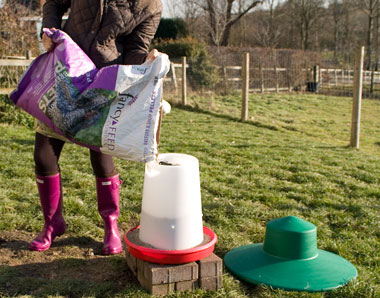


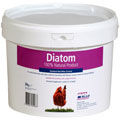

Were can I buy flubenvet 2.5 in the us California?
I don’t know anything about its availability in the US. There was an earlier comment from someone in the US who managed to get it though…
“One 6 g scoop treats 2 kg of food for chickens”. What is 6 g? I’ve only got three (White Sussexes) so can’t relate to your calibration. Thanks
6 grammes. You can weigh this on scales or use the scoop which is a 6g scoop. Mix this with 2Kg of food and feed to your birds for 7 days, throwing away the food you don’t use. If you want less, then mix half a scoop or 3g with 1Kg of food…
We are new to keeping chickens having bought four mixed POL in April of this year. One of our beautiful bantams died this week after a slow decline over about three months. We are scrupulous about cleaning hen house and run (20feet by 10feet) and use a good quality layers pellets (Garvo). In an effort to help her we used Verm-X in their food two weeks ago as well as adding poultry tonic to their water (fresh every two days). We gave her cod liver oil twice a day for about five days and she seemed to rally but then rapidly deteriorated once we stopped the cod liver oil. Our speckeldy is displaying the same symptons she did, stopped egg laying, pale crop and dirty bottom although she still seems alert and is eating. All our other birds which now include three twelve week cream legbar chicks reared by our other bantam, appear extremely healthy. How soon after treating with flubenvet can we expect to see an improvement in our poorly speckeldy and can we do anything else to help ensure our flock remain healthy?
Tough question. If the problem is worms, Flubenvet should kill them all but there can of course be considerable damage done by worms and this can be too much for the bird to cope with. If it was a moderate amount of worms, I would guess a week or two should see a hen perk up.
Remember if there has been a heavy infestation there will still be worm eggs on the ground in the run and in secondary hosts such as earthworms – so the flock will be re-infected. In this case, it’s best to re-treat after a couple of weeks to ensure these worms get killed, before they are adults and capable of laying more eggs (it’s called the pre-patent period).
It might not of course be a worm problem but it’s worth ruling it out before looking for other clues.
I found the easiest way to give Flubenvet is this. Cut a grape in half, lift part of the flesh from one half, sprinkle in a small amount of powder (normally I give a tiny amount off the handle end of a teaspoon), tap the grape flesh back in place, repeat for the other half. i now have two doses for two chickens which they gobble up quickly. By giving a piece of grape to one bird, then putting her outside the pen, I know which ones have been dosed and that they have all had an equal amount.
This is popular and I have read this on the forums, however remember it is not the licensed method. You cannot calculate how much a hen should be having and it is given in one big dose.
The licensed method is to add it at a certain dosage to feed and then birds get a different quantity according to what they eat, (which for healthy birds with an appetite corresponds to their weight). It is also a gradual dose over 7 days. By giving it all in one dose, the amount of Flubenvet appearing in eggs is untested and could be over the safe limit and you would therefore need a withdrawal period for your eggs.
Personally, I wouldn’t do this, with one exception – if a bird has worms and will not eat, it might be worth tempting her with this method and if she is that sick, is unlikely to be laying eggs anyway.
Should have mentioned, also could not buy flubenvet online as all outlets out of stock. Ordered instead Marriages Layers Pellets with Flubenvet and started feeding it yesterday. Keeping fingers crossed that this will do the trick.
There seems to be a supply problem at the moment. I contacted Elanco the makers yesterday to ask what’s happening and will let people know here when I get a reply.